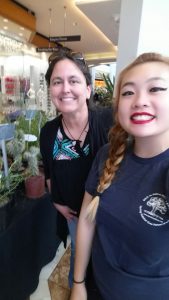
By Crystal Sayphraraj
My name is Crystal Sayphraraj and I am a senior about to graduate California State University, Fullerton. My experience with Back to Natives Restoration was truly incredible and an amazing self-learning experience. When I first started this internship, I was a bit skeptical on what I can do or learn from the organization.
For example, what are native plants? How does working for a native plant restoration non-profit help me in pursing and gaining experience for my Communications degree? All I knew when I began this journey was that I loved being outdoors and active so I thought to myself that working for an organization that spends a lot of time out in the wilderness would be exciting. In fact, this was one of the most beneficial learning opportunities I received from an internship.

Back to Natives Restoration has a passionate team of leaders that wish to inform and inspire the community about habitat restoration through service learning and native plant education.
Their mission is “To encourage and actively participate in the restoration and conservation of Orange County and California wildlands, through education and restoration programs featuring native plants and biodiversity as a centralizing theme.”
Even though I had no knowledge about native plants beforehand, the internship gave me the opportunity to brush up on some research skills. Instantly, I was assigned tasks to write press releases, create a video for the training class, media alerts, graphic design and social media posts.
Being a virtual internship, I did a lot of the assignments from the comfort of my own home computer. Director of Education, Lori Whalen, responded to my emails immediately and gave me direct feedback on what needed to be changed or what I succeeded on. After the changes were made, each document was scheduled for release.
I received the best feeling when I knew that an assignment I had worked on was being published.
The reason why this internship was so valuable was because we were assigned projects that corresponded with real events. I had the opportunity to go to a USFS training course, an IHeartOC event, and also the Spring Garden Show. These were all new events that I have not known about but had a positive experience attending all of them.
Executive Director, Reginald Durant, always displayed a leadership role in teaching the class, workshops or seminars on certain topics such as how to create a native habitat for Monarchs. You could hear the passion in his voice for every speech he gave.
Working for this non-profit organization has also made little affects in my daily routine. I remember during winter, they had construction on the whole campus and took out all the grass and some trees. I wondered what plans they had for these planters around school.
Walking around the CSUF campus, I noticed pretty flowers blooming in the spring. Instantly, I was able to recognize that all the plants were native plants. I was surprised myself that I could recognize these plants but it was a nice feeling to know that not only did I write for the organization but I was able to learn a little about the plants itself. Plants on campus range from Monkey Flower, Small Fescue, Coreopsis Lanceolata, Baby Blue Eyes and 16 more California Native and Adaptive Plants.
It’s interesting because initially, you don’t see how communications and native plant restorations correlate with each other but after completing this internship, I learned that communications is needed everywhere!
Yes, you can work for something you truly have a passion for, but how will you share your passion with others if you cannot market and display your work efficiently? With communications, the non-profit organization is able to gain followers on social media, receive grants, increase attendants at events they hold and just inform others of the good they are doing for the Orange County community.
Communications is the key to “inform and inspire” the community about habitat restoration through service learning and native plant education.
I was able to help Back to Natives Restoration for these short 3 months to achieve their marketing goals and also gain experience in communications writing and native plants.
I am truly thankful for the experience I received from Back to Natives Restoration and will take the knowledge I have learned to future endeavors.
